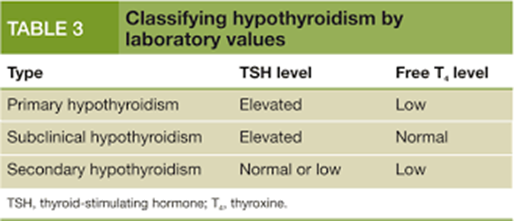A nurse is assessing a client who has chronic kidney disease. Which of the following findings is a manifestation of hyperkalemia?
Wheezing
Decreased deep tendon reflexes
Cerebral edema
Hypoactive bowel sounds
The Correct Answer is B
A. Wheezing is not typically associated with hyperkalemia. It can be seen in conditions such as asthma or chronic obstructive pulmonary disease (COPD).
B. Hyperkalemia can lead to neuromuscular manifestations, including decreased deep tendon reflexes due to suppression of neuromuscular excitability.
C. Cerebral edema is not a typical manifestation of hyperkalemia. It may occur in conditions such as hyponatremia or severe metabolic acidosis.
D. Gastrointestinal manifestations of hyperkalemia are typically related to smooth muscle involvement and can include hyperactive bowel sounds or diarrhea.
Nursing Test Bank
Naxlex Comprehensive Predictor Exams
Related Questions
Correct Answer is D
Explanation
A. In primary hypothyroidism, the thyroid gland fails to produce sufficient thyroid hormone.
Consequently, free T4 levels are typically decreased.
B. Although serum T3 levels may also decrease in primary hypothyroidism due to impaired thyroid function, TSH is the primary marker used for diagnosis and monitoring.
C. Similarly, serum T4 levels may decrease in primary hypothyroidism due to decreased synthesis by the thyroid gland.
D. In primary hypothyroidism, the anterior pituitary gland releases more TSH to stimulate the thyroid gland to produce thyroid hormones. Therefore, elevated TSH levels are characteristic of primary hypothyroidism.

Correct Answer is B
Explanation
A. Constipation is more commonly associated with hypothyroidism, not hyperthyroidism.
B. Hyperthyroidism can lead to emotional lability, anxiety, and irritability due to increased metabolic rate.
C. Weight loss is a common manifestation of hyperthyroidism, not weight gain.
D. Sensitivity to cold is more commonly associated with hypothyroidism, not hyperthyroidism.
Whether you are a student looking to ace your exams or a practicing nurse seeking to enhance your expertise , our nursing education contents will empower you with the confidence and competence to make a difference in the lives of patients and become a respected leader in the healthcare field.
Visit Naxlex, invest in your future and unlock endless possibilities with our unparalleled nursing education contents today
Report Wrong Answer on the Current Question
Do you disagree with the answer? If yes, what is your expected answer? Explain.
Kindly be descriptive with the issue you are facing.
